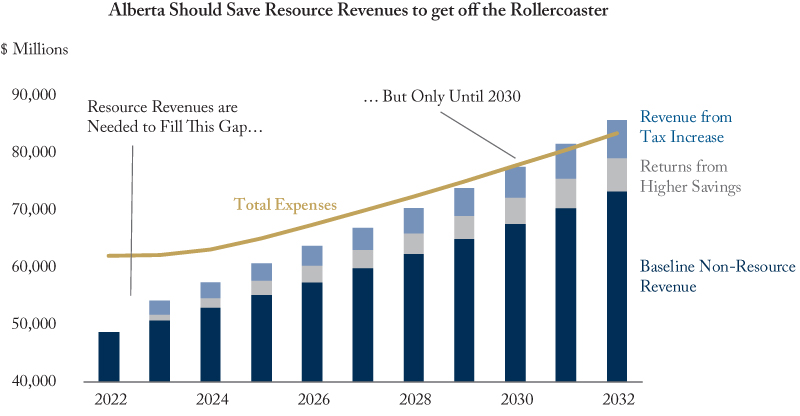To: Alberta Politicians of All Stripes
From: Trevor Tombe
Date: June 3, 2022
Re: A Plan to Secure Alberta’s Fiscal Future
A strong global recovery from COVID-19, combined with Russia’s Ukraine invasion, has driven energy prices to near-historic highs.
The current resource revenue windfall is an opportunity Alberta cannot ignore. And with a United Conservative Party leadership race underway and a provincial election soon to follow, now is the time to think big and plan for the future.
Much depends on oil prices, of course, which cannot be forecast with confidence. But markets are currently pricing in an average of $100 per barrel this fiscal year, $85 per barrel for 2023/24, and nearly $80 for 2024/25. If this comes to pass, the three-year windfall to the province may exceed $25 billion above what the government forecast in its 2022 budget. Nearly half of which may accrue this fiscal year alone.
Alberta’s budget was introduced the very same day Russia launched its Ukraine invasion. Oil prices spiked immediately, bringing an unplanned fiscal windfall to Alberta taxpayers. Managing this responsibly for the long-term benefit of Albertans will be critical.
An idea from 2015, proposed by former Premier Jim Prentice, is worth revisiting.
In advance of that long-ago budget (which never passed), Mr. Prentice detailed three clear goals: get costs under control; get program expenditures off the energy revenue rollercoaster; and maintain the lowest taxes in Canada.
These three objectives, even more than in 2015, present interesting guides for fiscal policy decision making in Alberta. They are simple and transparent, and may form the basis for a set of fiscal anchors (about which my colleague Bev Dahlby recently wrote.)
The first objective is largely achieved, with Alberta in 2022/23 expected to spend a similar amount per person as the average of British Columbia, Ontario, and Québec. And going forward, anchoring spending growth to no faster than inflation plus population growth will help ensure provincial finances remain sustainable.
This anchor also, interestingly, has cross-party support and was regularly committed to (even if not always abided) by the previous NDP government. Such a commitment is not easy. An aging population adds significant pressure to healthcare expenditures, the largest area of provincial government operations by far. But it is a worthwhile objective.
The second goal, discipline around resource windfalls, has, unfortunately, not seen the light of day since 2015. We could change that and phase in a new process to conserve resource revenues and rebuild the Heritage Fund. There are many feasible and modest options available.
Using a long-run model of Alberta’s provincial budget, I estimate that if current high prices gradually decline (as markets expect) and converge to a normal trajectory from 2025/26 onwards, the province’s net debt could fall below 10 percent by 2025.
The minimum bar of a savings plan should be Alberta saving every dollar of windfall resource revenues over-and-above it 2022 budget forecast (rather than paying down relatively low-cost debt). Using the Budget 2022 forecast revenues as the high-water mark of resource revenue to take into income, Alberta might be able to not only lower net debt levels but also save half of all resource revenues (Prentice’s plan) by roughly 2028. Investment returns on these higher savings add up, and fast. By the mid-2030s we could save 100 percent of resource revenues, assuming expenses grow only at population growth plus inflation.
All without new taxes.
While these three objectives would build a solid foundation, a truly farsighted policy would move us off the rollercoaster even faster.
New tax revenues of $2-3 billion per year would allow for Alberta to achieve zero net debt by 2030 and save 100 percent of resource revenues from that point forward. Alberta would also maintain a roughly $12 billion tax advantage relative to Ontario, the second-lowest tax province.
There are options to do this without undermining the third objective of maintaining low taxes: an Employer Health Tax as in British Columbia and Ontario, higher property taxes, taking back control of the carbon tax now levied by the federal government, or a small 2-percent general sales tax.
In the short term, saving half of resource revenues would insulate Alberta’s finances from unexpected swings. Over the past half century, only twice has Alberta seen resource revenues fall by more than half. This makes it a natural benchmark. But we could go further, and I suggest we do. I plot this more aggressive plan that includes modest new revenues in the attached Figure.
While we cannot predict the future, we can prepare for it. The current resource revenue windfall is an opportunity to ease Alberta off of its historic dependence on royalties, return public debt levels to below pre-COVID (and below pre-2015/16 recession) levels, and secure its fiscal future.
Trevor Tombe is Professor of Economics at the University of Calgary and a Research Fellow at The School of Public Policy.
To send a comment or leave feedback, email us at blog@cdhowe.org.
The views expressed here are those of the author. The C.D. Howe Institute does not take corporate positions on policy matters.






